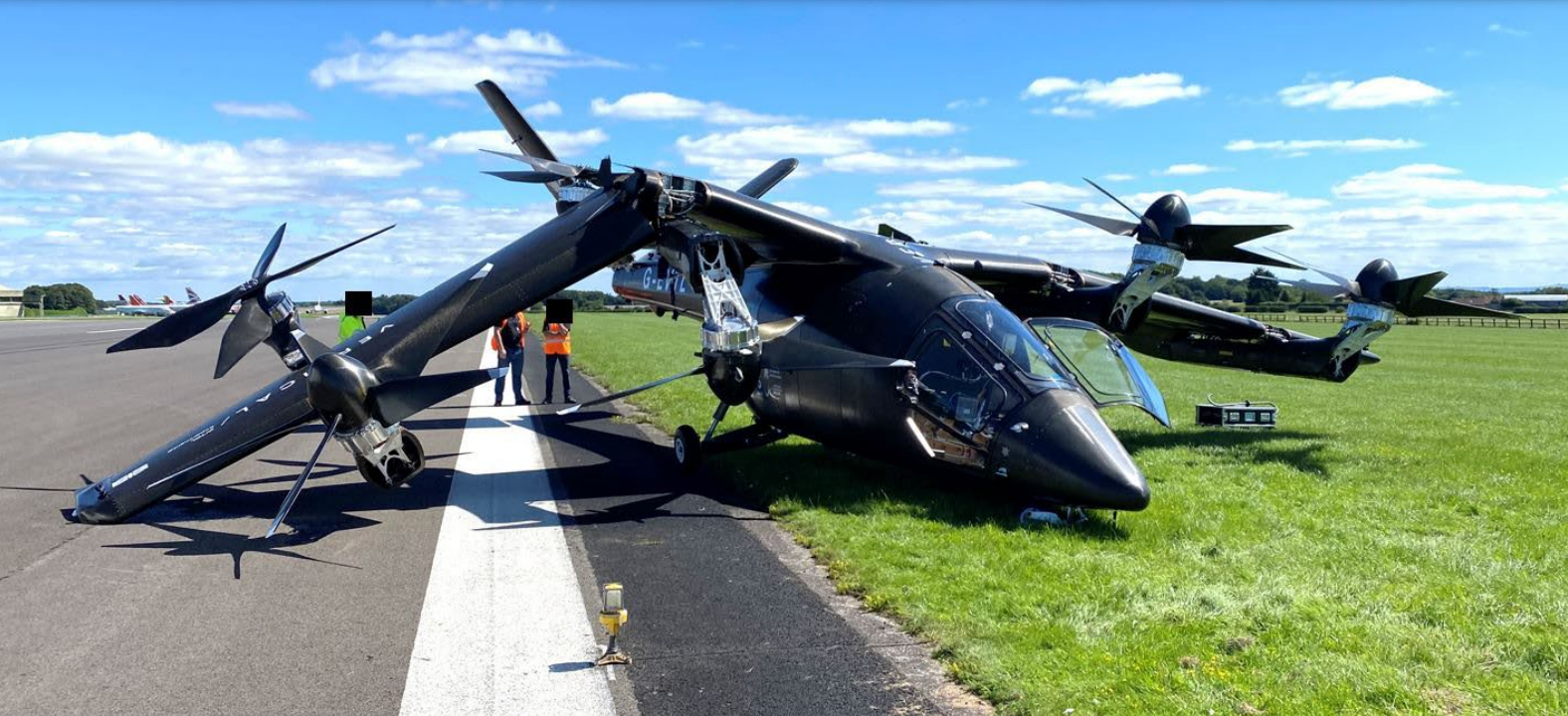
| Date: | Wednesday 9 August 2023 |
| Time: | 07:15 |
| Type: | Vertical Aerospace VX4 |
| Owner/operator: | Vertical Aerospace |
| Registration: | G-EVTL |
| MSN: | 001 |
| Fatalities: | Fatalities: 0 / Occupants: 0 |
| Aircraft damage: | Substantial |
| Category: | Accident |
| Location: | Cotswold Airport (GBA/EGBP), Gloucestershire -
 United Kingdom United Kingdom
|
| Phase: | Manoeuvring (airshow, firefighting, ag.ops.) |
| Nature: | Test |
| Departure airport: | Cotswold Airport (GBA/EGBP) |
| Cotswold Airport (GBA/EGBP) | |
| Investigating agency: | AAIB |
| Confidence Rating: |
A Vertical Aerospace VX4 e-vtol prototype suffered an accident during a test flight at Cotswold Airport.
The aircraft was being flown by a remote pilot on a test flight at 30 ft agl when a propeller blade detached from the electric propulsion unit 3 forward motor due to a failure of the adhesive bond between the propeller blade sheath and spar. Large out-of-balance loads generated by the blade release caused structural failure of the right inboard pylon, resulting in damage to the aircraft’s wiring harnesses. This caused a loss of thrust from motors 4 and 7. Whilst the aircraft’s flight control system was able to maintain a level attitude, the high rate of descent caused by the loss of vertical thrust resulted in substantial damage to the aircraft when it struck the ground.
The aircraft manufacturer was, at the time of the accident, in the process of introducing a blade design that, amongst other things, eliminated the bonding failure mode that caused the blade release. The manufacturer’s investigation identified 36 product and process improvements resulting from findings of the investigation.
=Safety actions=
As a result of this accident, the manufacturer has taken the following safety actions:
● The remaining ‘Generation 1’ propeller blades were withdrawn from use and, subject to a satisfactory inspection, will only be used for ground testing.
● The manufacturer was in the process of introducing a new ‘Generation 2’ propeller blade when the accident occurred that, amongst other things, eliminated the bonding failure mode that caused the blade release.
● Having completed its internal accident investigation, the manufacturer identified 36 product and process improvements. These include improvements in quality control, supplier qualification, design and verification processes, flight control laws, CAN bus architecture and the routing of wiring harnesses
=AAIB Conclusion=
The blade released from EPU3 was caused by a failure of the adhesive bond between the propeller blade sheath and spar. It is likely that defects introduced in the bond when the blade was manufactured grew progressively larger during the blade’s operational service to the point that the remaining bond area was insufficient to retain the blade under normal operating loads.
Large out-of-balance loads generated by the blade release caused structural failure of the right inboard pylon, resulting in damage to the aircraft’s wiring harnesses. This caused a loss of thrust from motors 4 and 7. Whilst the aircraft’s flight control system was able to maintain a level attitude, the high rate of descent caused by the loss of vertical thrust resulted in substantial damage to the aircraft when it struck the ground.
The manufacturer identified the propeller blade’s structural design, the manufacturing controls, quality assurance processes and verification programme as contributory factors
=Damage sustained to airframe=
Per the AAIB report "Damage to right wing, fuselage, landing gear and engine pylon"
 |
|
1. AAIB Final Report: https://assets.publishing.service.gov.uk/media/6632544902f02aa4f31e4143/VA-1X_G-EVTL_06-24.pdf
2. https://evtol.news/vertical-aerospace-VA-1X
3. https://www.flightglobal.com/aerospace/vertical-faces-setback-after-vx4-prototype-crashes-during-flight-testing/154475.article
4. https://theaircurrent.com/aviation-safety/vertical-aerospace-details-failure-sequence-that-preceded-vx4-crash/
5. https://pilotweb.aero/news/vertical-vx4-evtol-damaged-in-flight-testing-incident/
6. https://simpleflying.com/vertical-aerospace-vx4-evtol-crashes/
7. https://www.globalair.com/articles/cause-of-vx4-evtol-test-flight-crash-revealed-in-program-update?id=6310
8. https://en.wikipedia.org/wiki/Vertical_Aerospace#VX4

Photo: Pylon 3 failure following the release of a propeller blade from EPU3 (courtesy of manufacturer)

Photo: G-EVTL after the accident (AAIB)
A report has been published into an accident involving an VA-1X (G-EVTL), which suffered a forced landing following power unit failure, Cotswold Airport (Kemble), Gloucestershire, 9 August 2023.https://t.co/A1h7lbzRTI#aviation #aviationsafety pic.twitter.com/aWzCven3pP
— AAIB (@aaibgovuk) May 2, 2024
Vertical Aerospace has suffered what appears to be a significant setback after the electric vertical take-off and landing (eVTOL) aircraft crashed during an unmanned test flight https://t.co/4HvYnqrmCm pic.twitter.com/DZ708GsMAz
— Evans Electric (@tsport100) August 10, 2023
Bad news from@VerticalAero
— Charlotte Bailey (@penandpaper1989) August 9, 2023
at Cotswold Airport, where - according to an airfield source - the VX4 #evtol has crashed from approximately 20ft during an unmanned inflight shutdown as part of its ongoing testing programme. Significant structural damage shown in the image below: pic.twitter.com/C6OJzRVYAk
| Date/time | Contributor | Updates |
|---|---|---|
| 09-Aug-2023 12:39 | harro | Added |
| 09-Aug-2023 12:41 | harro | Updated |
| 09-Aug-2023 13:21 | hmmptwizzle | Updated |
| 09-Aug-2023 20:57 | Iceman 29 | Updated |
| 09-Aug-2023 22:09 | Aerossurance | Updated |
| 10-Aug-2023 16:02 | Iceman 29 | Updated |
| 31-Aug-2023 09:42 | harro | Updated |
| 02-May-2024 19:09 | Dr. John Smith | Updated [Time, Source, Embed code, Narrative] |
| 02-May-2024 19:11 | ASN | Updated [Embed code, Narrative, Accident report] |
| 06-May-2024 20:07 | Captain Adam | Updated [Photo] |
| 06-May-2024 20:07 | Captain Adam | Updated [Photo] |


 ©2024 Flight Safety Foundation
©2024 Flight Safety Foundation